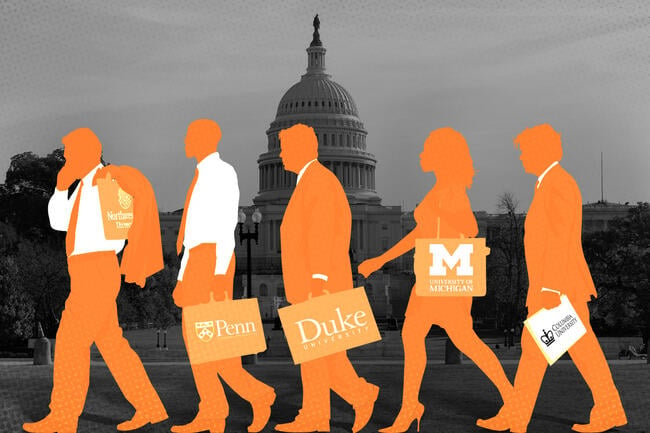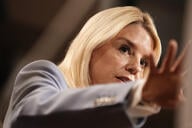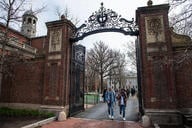You have /5 articles left.
Sign up for a free account or log in.

Photo illustration by Justin Morrison/Inside Higher Ed | Suyash Mahar/pexels | rawpixel
As President Trump’s broadside attacks on higher education continue, few institutions have shown a willingness to push back publicly. But behind closed doors, the sector has already pumped millions of dollars into federal lobbying efforts this year to plead their case in Washington.
An Inside Higher Ed analysis of federal lobbying data shows that some of the universities in Trump’s crosshairs have dramatically increased spending this year compared to the first quarter of last year, hiring advocates on the Hill to represent their interests to lawmakers. Northwestern University, for example, has already spent more than $600,000 on federal lobbying this year, compared to $110,000 in the first quarter of 2024. Among individual institutions, Northwestern has spent by far the most on lobbying this year.
Northwestern is one of multiple institutions that the Trump administration has taken aim at in recent months, abruptly freezing hundreds of millions of dollars in federal research funding over alleged incidents of antisemitism on campus connected to a pro-Palestinian encampment last spring, or the participation of transgender athletes in women’s sports.
(Northwestern did not respond to multiple requests for comment.)
Here’s a look at what institutions, namely research universities, have spent on lobbying in the first quarter of 2025, and what issues they have emphasized.
Lobbying Expenditures
Since the analysis is focused on research universities, many of which have come under attack by the Trump administration, Inside Higher Ed reviewed the lobbying expenditures primarily by members of the Association of American Universities. Together, they’ve spent almost $9 million this year.
Areas of focus, according to lobbying disclosures, include federal caps on indirect research cost reimbursements, endowment taxes, the upcoming appropriations bill, international student visa issues, athletics and various pieces of legislation, including the College Cost Reduction Act.
Several institutions targeted by the federal government are among the highest spenders, including Columbia University, which mostly yielded to a list of Trump administration demands in March. Now federal officials wants more from Columbia, including a possible consent decree. While Columbia has publicly conceded on many fronts, it has quietly worked through back channels in Congress, spending $270,000 on lobbying in the first quarter of 2025. Among the lobbying activities listed: “Outreach and monitoring related to … NSF Funding, and NIH funding, generally.”
Last year, the university spent $80,000 on lobbying in the first quarter and a total of $350,000 for 2024. Given Columbia’s spending so far this year, it is likely to surpass that in 2025.
“Columbia values its relationships with our delegation and other officials across all levels of government,” a spokesperson wrote in an emailed response to Inside Higher Ed. “We are eager to tell our story on the vast impact Columbia research and contributions have had on improving lives and generating solutions to society’s most pressing challenges.”
Other Trump targets, such as the University of Pennsylvania, Yale University, and Harvard University, have also increased lobbying expenditures. Both Penn and Yale spent $250,000 in the first quarter of 2025, followed closely by Harvard at $230,000. Those are noticeable increases from last year, when Yale spent $180,000 on lobbying in the first quarter, Penn spent $150,000, and Harvard spent $130,000.
Other Top Spenders
While the focus of Inside Higher Ed’s analysis was AAU members, a few universities outside that organization also cracked the top 10 in lobbying expenditures for the first quarter of 2025.
After Northwestern, the University of Phoenix has been the top spender on federal lobbying efforts this year, shelling out $480,000 in the first quarter. However, unlike at many other institutions, that number does not represent a significant increase of typical spending.
Last year, Phoenix, a for-profit institution, spent $1.8 million on federal lobbying.
Priorities for the university, according to a lobbying disclosure, include such issues as “change of control, and related regulatory requirements.” Phoenix has been lobbying on change of control since at least the spring of 2023 amid efforts to sell the university, which have yet to materialize.
Northeastern University, which is a research institution but not an AAU member, is also among the country’s top spenders; it laid out $270,000 for lobbying in the first quarter. But that number mirrors what the university spent in each quarter last year as it racked up more than $1 million on lobbying.
“Like all major research universities, Northeastern engages with the federal government at many levels,” Renata Nyul, Northeastern’s vice president for communications, wrote in an email to Inside Higher Ed. “We work to increase funding for our expanding research enterprise, shape federal policy that affects higher education, and maximize support for student financial aid.”
Some small liberal arts colleges have also hired federal lobbyists for the first time.
Is It Working?
Experts find the increase in lobbying expenditures unsurprising for two reasons. First, there is typically an uptick in lobbying efforts in the early days of a new presidential administration. Second, sectors tend to lobby heavily when presented with new opportunities or major change.
“Many of the Trump administration’s actions pose existential threats, so universities should be working to address those threats in any way possible. That includes lawyers, appeals to public opinion, all of it, because there have been so many things that affect universities in the first 100 days,” said Beth Leech, a political science professor and lobbying expert at Rutgers University.
Leech pointed to research funding cuts; rescinded grants; Trump’s broadsides against diversity, equity and inclusion programs; and attacks on academic freedom as key concerns for higher ed institutions.
She noted that colleges hire lobbyists not only to better understand emerging threats but also to engage lawmakers in conversations about what legislative proposals would mean for higher education.
“A lot of lobbying is informational, and it’s informational on both sides. The lobbying organization needs to monitor potential threats—not just the Trump administration, but everything that affects an organization, a company, or whatever,” Leech said. “They need to be able to communicate about the impacts of potential threats, because sometimes things come up [in legislation] and lawmakers are just not aware of what some of the implications of some plan might be.”
Universities are spending heavily on lobbying at a time when the Trump administration appears to be at war with higher education, slashing federal research funding—often without informing institutions—and punishing universities before investigations are concluded. But is it working?
“They have to try,” Leech said. “They can’t just stand aside and let whatever happens happen.”




